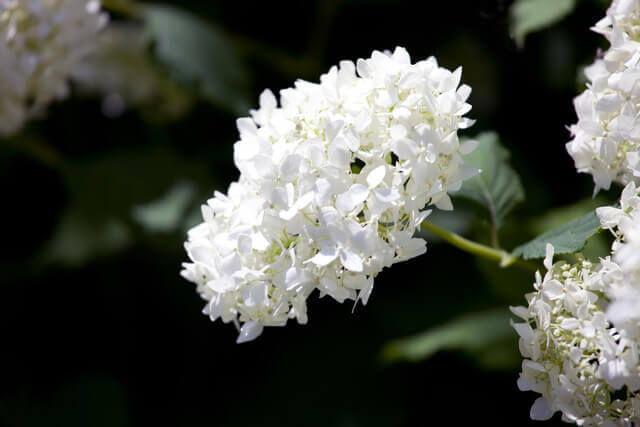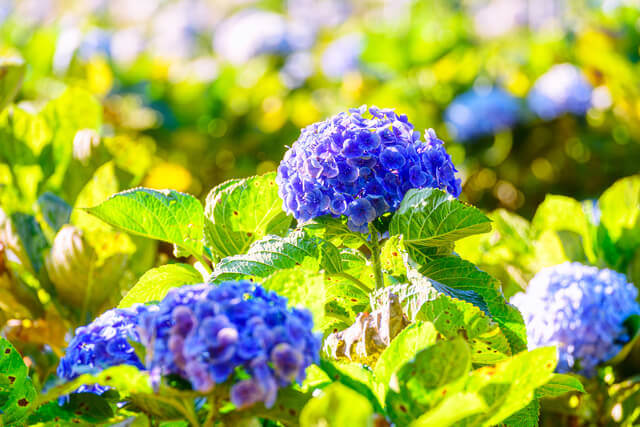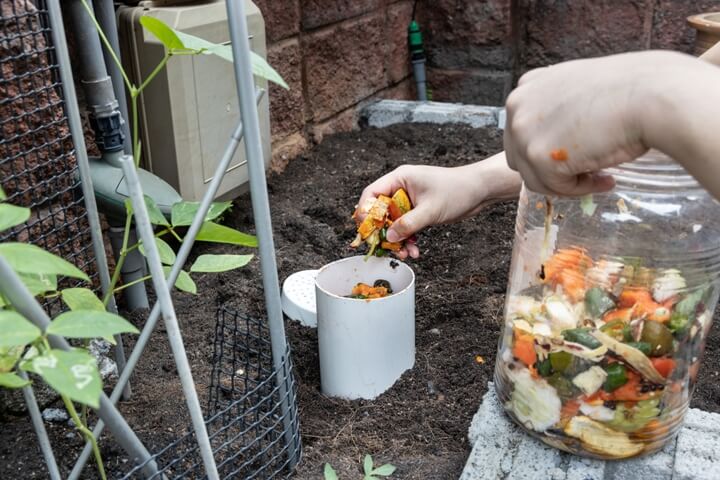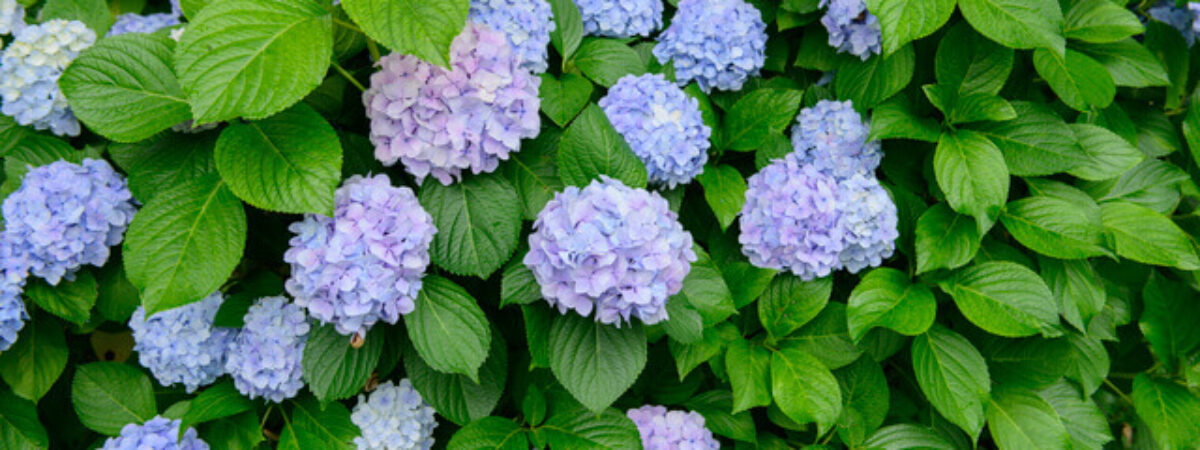Hydrangeas are one of the most beautiful and popular flowering shrubs in North America. They have amazing showy flower heads of vibrant colors.
Though Hydrangeas are easy to grow, they need proper care by applying fertilizer for their proper growth and development.
They come in various colors: blue, purple, white, red and pink. This beautiful shrub requires acidic well drained soil to grow.
Hydrangeas bloom in summer and fall which is the best time to provide them proper nutrition through fertilizing them.
But wait, before applying fertilizer to Hydrangeas plants, you need to know the type of Hydrangeas you have, because each type requires different nutrition for their growth.
Here is a complete guide to fertilize your Hydrangeas at the right time and with the right amount.

Types of Hydrangeas
There are mainly six types of Hydrangeas that depend mainly upon soil pH. It is most important to have some idea on the types of these plants so as to apply the right fertilizer.
Bigleaf Hydrangea known as French Hydrangea scientifically called Hydrangea macrophylla comes mainly in blue color. Click To TweetBigleaf Hydrangea
Otherwise known as French Hydrangea scientifically called Hydrangea macrophylla comes mainly in blue color but it has other colors too based on soil acidity.
If the soil pH is less than 5.5 the cultivar is blue in color, between pH 5.5-6.5 the cultivar is mauve in color and above 6.5 pH the cultivar is pink in color.
Some of the cultivars remain unaffected by soil pH and hence they are white in color.
Mountain Hydrangea
Scientifically known as Hydrangea macrophylla var. Serrata. Like Bigleaf Hydrangea this variety also consists of various colors.
If the soil pH is less than 5.5 the cultivar is blue in color, between pH 5.5-6.5 the cultivar is mauve in color and above 6.5 pH the cultivar is pink in color.
Smooth Hydrangea
Scientifically known as Hydrangea arborescens. It comes in two types of cultivars: white and pale green.
Panicle Hydrangea
Scientifically known as Hydrangea paniculata. It comes in two types of cultivars: white and pink/light green.
Oakleaf Hydrangea
Scientifically known as Hydrangea quercifolia. It comes in two types of cultivars: creamy white and ros.
Climbing Hydrangea
Scientifically known as Hydrangea anomala subsp. petiolaris. It comes in white colored cultivars.

Blue Hydrangeas
The two types of hydrangea i.e bigleaf (Hydrangea macrophylla ) or mountain hydrangea (Hydrangea Serrata). The blue color of the flower is due to the presence of Aluminium in the tissue.
Aluminium is available in acidic soils, so if you’re growing blue Hydrangeas then make sure that your soil has acidic pH. In case of high pH your plant will have pink flowers.
If your soil’s pH is high and you want to grow these Blue Hydrangeas then you can also lower the pH by applying acidic fertilizers like Aluminium sulphate or wettable sulfur.
The quantity solely depends on your existing soil pH and type of the soil. Be cautious while applying Aluminium sulfate as too much of it can harm the plants.
Mainly there are three forms of fertilizer for Hydrangeas i.e. Liquid fertilizer, Granular fertilizer and Compressed Spikes. Click To TweetType of fertilizer
Like every other plant, Hydrangea too requires all nutrients that includes both macro and micro nutrients. Usually an all purpose fertilizer that comprises Nitrogen- Phosphorus- Potassium in a particular ratio works great for these plants.
You can use a NPK ratio of 10-10-10 or 12-4-8 or 15-30-15, these are basically nursery standard NPK ratios.
Mainly there are three forms of fertilizer for Hydrangeas i.e. Liquid fertilizer, Granular fertilizer and Compressed Spikes.
Liquid fertilizer
Liquid fertilizers are best among all as they provide a proper amount of nutrients to the plants. The roots and leaves absorb the nutrients properly.
Usually the concentrated nutrients are diluted in water and then sprayed on plants based on the required quantity.
Granular fertilizer
These are one of the ready to use fertilizers that can be used either diluted in water or sprinkled around the plants base to get dissolved by roots.
The granules are usually coated with polymers which when used in the base of the plants dissolve slowly and have quite a long lasting effect.
Compressed Spikes
The compressed spikes can also be used as long-term fertilizer. This is because they are easy to shovel into the soil around plants’ bases. Once buried, spikes slowly dissolve over a period of two to three months.

Organic fertilizer
Although there are many inorganic fertilizer options for Hydrangeas plants, using organic fertilizers always works best not only for plants but also for your soil health.
Normally, they are made up of earthworm castings, poultry manure, compost, or other natural ingredients. Hydrangeas benefit from an organic mix of sulfur, compost, and peat moss.
You can get great results if you use composted manure that can be applied around the base of the plant on a yearly basis.
How and when to fertilize Hydrangea?
As we have discussed earlier about the type of fertilizer best suited for Hydrangea, it’s time to know how to fertilize them.
If you are applying a slow release fertilizer, then it is always advisable to apply it once a year as they are long lasting. Always apply fertilizer during spring and early fall, especially slow release fertilizer.
Overfertilizing will harm your plants and might burn the leaves. Slow release fertilizer should be applied around the drip line of the branches but not on the base. Always cover the fertilizer with compost or soil so that it can get activated.
Be cautious while applying fertilizer as it shouldn’t reach the trunk or stems of Hydrangeas. Water the area so that fertilizer will get soaked in the soil and get absorbed by the roots easily.
If you notice that the leaves are turning yellow then a bit of liquid iron dosage will help to resolve the issue in the initial stage.
Never fertilize your Hydrangea during winters as the growth during this period due to nutrients will harm the plant in the long term. Winter is the time when plants protect themselves and don’t really want to grow .
Apart from these, here is a brief on how and when to fertilize your Hydrangea if you want any of the following factors
Flower Growth
As already discussed that Phosphorus and Magnesium plays a key role in initiating flower growth, a fertilizer having adequate Phosphorus and Magnesium will work wonders for these plants.
Both of these elements will be available in acidic soil, so it is required to maintain the pH of the soil if you want your Hydrangeas to bloom beautifully.
You can try adding vinegar dissolved in water to the roots of the plant that not only is a good source of Phosphorus, Potassium and Magnesium but also helps to retain soil acidity.
Green leaves
As you know that Nitrogen is essential for green leaves growth, applying adequate Nitrogen will help to get better greener leaves.
Aquarium water is a great source of nitrogen which you can apply once a month. Make sure to check on the nitrogen content because too much of it will reduce flower growth. So minimum is the key.
Flower colors
Hydrangeas bloom in various colors that majorly depend upon soil pH. So if you are someone who loves adding blue Hydrangea to your garden, then you should definitely have an acidic soil.
Adding vinegar to the soil can make it acidic or else applying acidic fertilizer such as wettable sulfur will also help retain acidity.
If you love having Pink blooming Hydrangeas then you should definitely go for basic fertilizers such as Calcium Carbonate or add some wood ashes to the soil in order to increase soil pH.
In the case of White or Green Hydrangeas, they really don’t change their colors depending on soil pH. So any soil pH range is good for them to grow and retain their blossom color.
Conclusion
As you have read this article so far, I hope you must have got a clear idea on how to take care and feed your Hydrangea plants with proper nutrition.
No matter if you are an experienced gardener or a beginner, you will definitely love to plant these beautiful showy cut flowers. Hydrangeas are one of the graceful flowers that every gardener loves to have.
So you should definitely prepare your soil this summer to plant these beautiful and elegant Hydrangeas in your garden.






